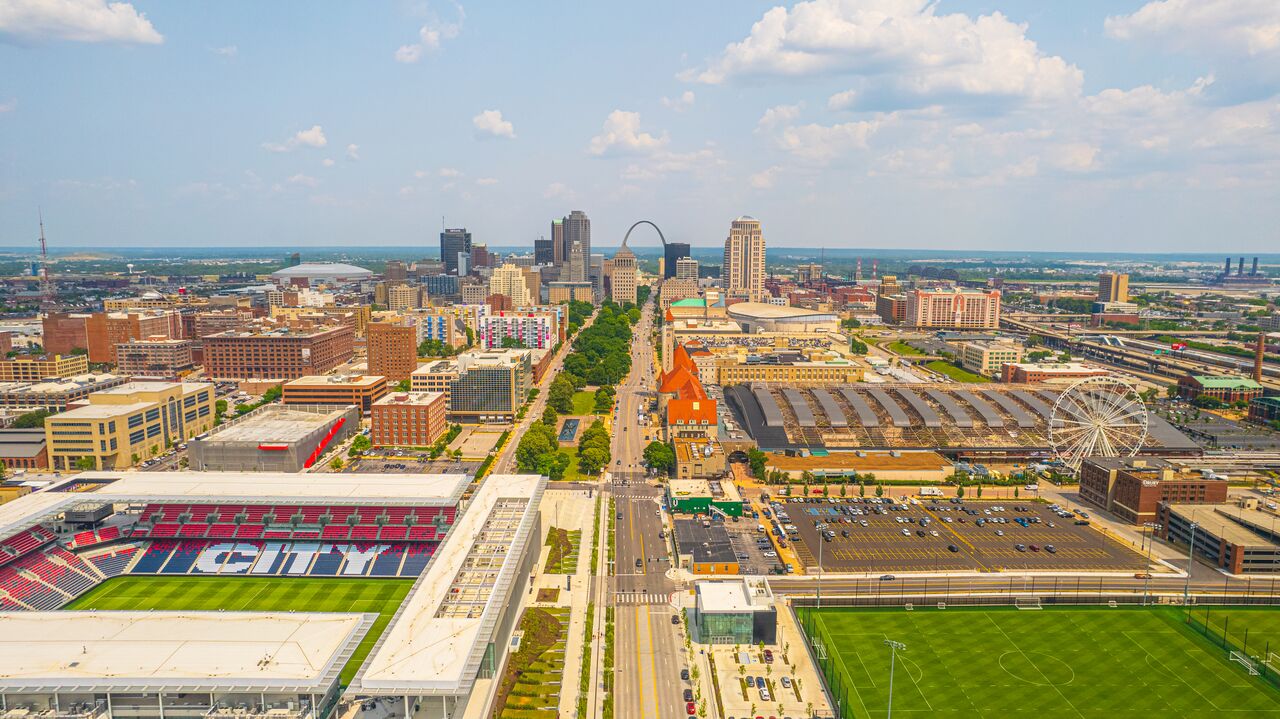St. Louis Uncovered — a Rich Tapestry for AIIP 2024 Symposium Attendees

Attending AIIP 2024 Symposium brings the thrill of meeting colleagues, broadening your knowledge and understanding of running an independent information business, and the excitement of new ideas – plus renewed energy and confidence.

For those attending in person, there’s more – the opportunity to get a glimpse of a city that grew to prominence because of its location on the banks of the great Mississippi River. Within walking distance of the conference hotel downtown, you’ll see a bit of history in the brickwork and stone carvings, the grand buildings, and the visionary and cultural aspirations of a vibrant mercantile city.
The late 1800s to early 1900s was St. Louis’ heyday as a commercial, manufacturing and transportation center. A brief look at its history helps make sense of what you’ll see when exploring the downtown area.
The city was founded in 1764 on the west bank of the Mississippi River by French fur traders. Others thought it was a good location for trade, too – just miles to the northeast in Illinois are remains of the largest pre-Columbian settlement north of Mexico, and there were many Native ceremonial mounds throughout the downtown area (sadly, destroyed in the 1800s). An early nickname for St. Louis was “Mound City.”
This small fur trading outpost developed into a center of trade for fur trappers along the Mississippi River. After the 1803 Louisiana Purchase added over 800,000 square miles to the U.S. territory west of St. Louis, trade also started looking westward.
By the mid-1800s, St. Louis had become a major trading hub for goods and agricultural products traveling to all points of the US. Businesses of all kinds flourished, and European immigrants came to the area. For pioneers setting out for a new life in the West, or for anyone seeking fortune in the mid-century California Gold Rush, St. Louis was the “gateway” city, one of the last places to get outfitted for the long journey westward.
The U.S. Civil War (1861-1865) interrupted St. Louis’ mercantile and trading activities, but its position as a major trade, transport and the production hub was reestablished after the war. St. Louis became one of the nation’s largest makers or shippers of cotton, foodstuffs, tobacco, clothing, shoes, beer, and fire brick.
Transportation connections made St. Louis a center for warehousing and wholesaling goods by the turn of the century. The steady number of people moving west to farms and newly formed towns created a need for farm equipment, supplies, materials, and manufactured goods to support the production of crops and raw materials. Thus, hardware, groceries, cans, coffee, dry goods, shoes, clothing, lumber, and furniture either started in or passed through the St. Louis economic gateway.

When the “world came to St. Louis” for the World’s Fair and the Summer Olympics in 1904, St. Louis was the 4th largest city in the U.S. after New York, Philadelphia, and Chicago. Its magnificent Union Station was among the largest rail terminals in the world, and the city had become a brewing center – Anheuser-Busch was the world’s largest brewery. One of the first fully formed skyscrapers, the Adler and Sullivan-designed Wainwright Building (rust-colored building in photo), rose over the city, and Washington Avenue was a center of the garment and shoe industry.
Here are some of the historically significant sites within walking distance of the conference hotel:
Gateway Arch, Old Courthouse, Old Cathedral, Laclede’s Landing and Riverfront, Eads Bridge, Wainwright Building, Railway Exchange Building, Washington Ave., Old Post Office, Arcade Building, Federal Reserve Bank, St. Louis Public Library, Christ Church Cathedral, Union Station, and City Hall.
For more on what to see in the St. Louis area, check out the AIIP 2024 Symposium Explore St. Louis page on the AIIP website, and meet us in St. Louis in April!
REFERENCES
- Wikipedia Timeline of St. Louis
- History of St. Louis (1866 – 1904); Wikipedia
- St. Louis Brewing History
- Immigrant Neighborhoods: The Backbone of St. Louis
- A Preservation Plan for St. Louis
Part I: Historic Contexts 3 – Business, Commerce & Industry
Susan Baerwald has been an AIIP member since 2012. She does secondary research for architectural, engineering and construction firms around the U.S. She’s lived for years in St. Louis and loves discovering how the city’s history is reflected in its built environment. You can find her at baerwaldresearch.com or contact her at susanmbaerwald@gmail.com or 314-954-2079.





